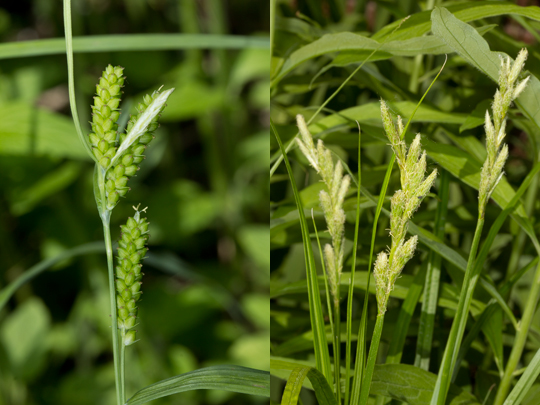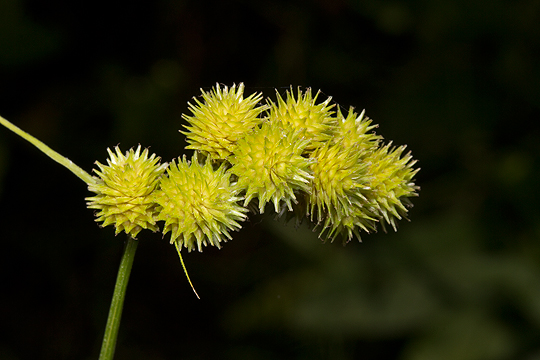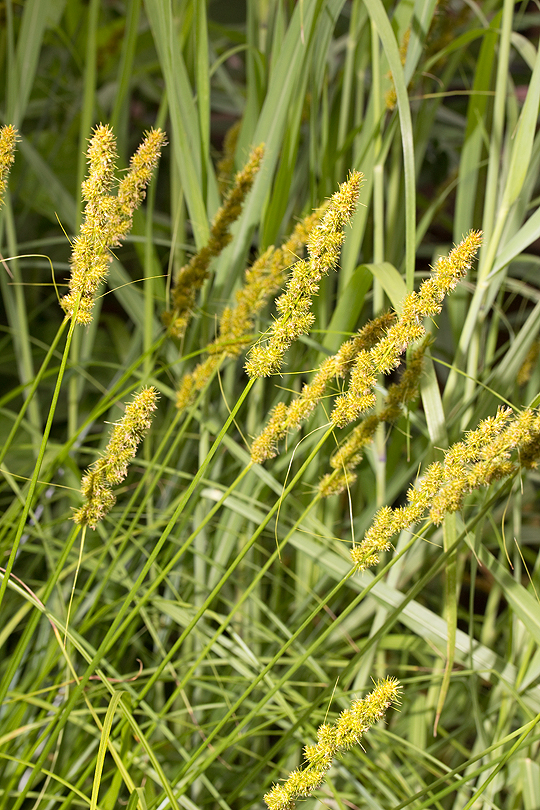Sedges - unsung heroes in wildlife gardens
The vast majority of sedges belong to the genus Carex, which in North America would contain several hundred species. At first glance, they look like grasses and they are actually a great alternative in shadier and wetter places where many grasses cannot grow. The leaves have a strong midvein and if you draw your thumb and forefinger up the leaf, it may feel quite rough. The stems of sedges are triangular rather than round and they lack the swellings at the nodes that are present in grasses. The flowers, which appear in the spring on stalks, often contain white staminate flowers and yellow pistillate flowers in separate locations.
| |
 |
|
| |
In this particular case, the male part of the flowers is above the female. This is Carex plantaginea which has distinctive flowers for a sedge. The white pistillate flowers emerge before the pollen bearing staminate flowers in order to encourage cross-pollination. |
|
The seed bearing head on sedges is the most noticeable feature in distinguishing them from grasses; it is called a perigynium and looks like a sac that tapers to a point due to the presence of teeth. Clusters of perigynia form a spikelet that is often diagnostic in identifying sedges as they take many different forms.
| |
 |
|
| |
On the left is Carex granularis with a cylindrical spikelet. On the right is Carex muskingumensis which has flattened spikelets. There are many different forms. |
|
Why every wildlife gardener should plant sedges
Sedges are often overlooked by gardeners because they do not produce showy flowers; however, what they lack in colour, they more than make up for by providing texture. If you do some research, you will probably find a sedge that suits your needs.
Sedges can provide a luscious growth where grasses cannot. In these places, they can also be grown as a natural no-mow lawn substitute and since many of them produce fibrous root mats, they are good for erosion control.
They can be planted in between flowering plants as a living mulch with root systems that slough off each year to add organic matter to the soil. This will save you money each year as well as increasing the visual appeal of your garden.
They are fantastic for wildlife gardens by acting as a host plant for many insects, supporting birds with their seeds, and by providing cover.
It is well beyond the scope of this website to provide information on every sedge out there. Here is a list of commonly available sedges that would be appropriate for a garden setting.
Sedges of woodlands and prairie
Carex appalachica (Appalachian sedge) 
This sedge resembles a fine grass and it is a native of dry woods. The sedge flowers in spring and given that it only grows 10 inches high, it would make a good substitute for grass in dry shade. It will not tolerate the prolonged wetness that you would find in heavy clays.
Carex brevior (Plains Oval Sedge) 
Plains Oval Sedge is quite adaptable and therefore easy to grow in a garden. It also tolerates dryness well and part-shade. The leaves are less than 1 foot high and this plant can be used as a lawn alternative in low traffic areas. With the inflorescences the plant will reach nearly four feet high.
Carex eburnea (Bristle Leaf Sedge) 
Bristle Leaf Sedge would be a good candidate as a lawn substitute where the amount of sun would make it difficult to maintain a lawn because it only grows 10 inches high and has fine leaves. It can tolerate dry and shady conditions is found in wooded areas with limestone rock.
| |
 |
|
| |
Carex eburnea is a tough sedge with fine leaves that spreads slowly. |
|
Carex pensylvanica (Pennsylvania Sedge) 
This cool season sedge is quite adaptable to garden conditions as it grows naturally in dry upland forests. This sedge is sod forming and spreads in moderate amounts. It would make a good lawn substitute in shady low traffic areas with its fine leaves that only grow to about 10 inches.
| |
 |
|
| |
This Pennsylvania sedge was photographed in the dry shade of a maple tree and while it grows slowly, it does a lot better than grass would. |
|
Carex plantaginea (Plantain Sedge) 
This sedge is quite similar to the Carex platyphylla in that it has distinctive broad leaves about an inch thick and grows well in the shadier parts of the garden, but it naturally prefers soils richer in organic matter that are better are retaining moisture. It would grow well with low spring flowering plants such as Trillium. One of my favourite sedges for a woodland garden
| |
 |
|
| |
Carex plantaginea |
|
Carex platyphylla (Broadleaf Sedge) 
The leaves of this plant are about 1 inch wide while and are less than a foot tall, so it certainly lives up to its name. It is quite an adaptable plant and would serve well as a filler. It tolerates shade well and could serve as a lawn substitute. This plant is similar to Carex plantaginea except for the colour; the broadleaf sedge has bluish green leaves.
Carex rosea (Rosy Sedge) 
Carex rosea is an adaptable sedge that prefers part shade rather than complete shade. It tolerates dryness well and can grow in sandy soils. It is not recommended for clay soils. The leaves grow up to 1 foot long. It is a true woodland sedge. 
Sedges of wetlands
Some of these sedges are strictly wetland plants and a few others may grow in gardens where some moisture is maintained. Typically, these latter plants grow naturally in bottomlands where drainage is slower and along streams or seeps.
Carex aurea (Golden Sedge) 
This is a small sedge that will spread easily if given the right conditions. It prefers damp soil that overlays limestone next to bodies of water. It grows well in the spring season. If your garden backs on to water, then this would be a good sedge.
Carex bebbi 
This cool season sedge needs a permanently moist soil to survive. It is a native of wet meadows and marshlands that are permanently submerged. It also needs an alkaline soil and full sun to do well. It grows about 3 feet high and can achieve full maturity in one season.
Carex comosa (Bristly sedge) 
If you have an area with permanently wet soil in full or part-sun, then this plant is a must. It grows up to 4 feet tall with tubular female spikes that are nearly 3 inches long, hence it is also known as the bottlebrush sedge. It provides food for many different insects as well as seeds for birds. It is widespread in Eastern USA and Ontario.
| |
 |
|
| |
Donacia is a common beetle in wetlands where its larvae feed on submerged root systems. In this stage of their life-cycle, they obtain oxygen by using some of the plant's own supply. They are associated with a number of wetland plants including several sedges. |
|
Carex crinita (Fringed sedge) 
Carex crinita might grow quite well in regular garden soil as it seems adaptable. It can grow in anything from standing water to soil that suffers occasional dryness. This plant is quite easily identified by the pendulous spikelets that are up to 4 inches long and supports lots of insects. It grows about 2-4 feet high and will tolerate light shade.
Carex cristatella (Crested sedge) 
Carex cristatella will grow quite well in regular garden soil with regular watering. In the wild, it grows close to the water line in areas with moist soil and it grows in thickets, so it does not need full sun. The spikelets are globular and clustered together which gives them a distinct and attractive appearance. The height of this plant is about 2 feet tall.
| |
 |
|
| |
The spikelets of Crested Sedge |
|
Carex granularis (Limestone Meadow sedge) 
Carex granularis grows just over 2 feet high and needs a good amount of sunlight. It is very happy in wet soils especially those that form on alkaline rocks. It feeds a wide range of insects. In a garden setting, this plant is quite adaptable, tolerating sandy soils with some supplemental watering.
| |
 |
|
| |
Gray's sedge will make a striking plant with its distinctive flowerheads that resemble a mace. |
|
Carex grayi (Gray’s sedge) 
If you have a shady garden with moist soil, then this sedge is particularly recommended due to the large numbers of insects and birds that it supports. It grows to about 3 feet high and has distinctive spike that looks like a mace, which was used as a weapon in historical times. The plant can be found naturally in woods next to rivers or in bottomlands where occasional flooding occurs as well as in wetlands.
| |
 |
|
| |
Gray's sedge |
|
Carex hystericina (Porcupine sedge) 
This sedge is a native of fens and other neutral or alkaline wetlands. It grows up to 2 - 3 feet high in full sun and supports a wide range of insects and birds. It has interesting spikelets that are densely packed with perigynia that have distinctive long and pointed tips.
Carex lupulina (Hop sedge) 
Carex lupulina is native to forested wetlands so it can tolerate light shade. It grows up to 4 feet and it is yet another wetland sedge that produces attractive pistillate spikes and supports a variety of wildlife.
| |
 |
|
| |
Porcupine sedge, Carex hystericina, prefers a slightly alkaline soil but can grow well in many gardens where a moisture regime is maintained. |
|
Carex muskingumensis (Palm sedge) 
A great native sedge for a container where you can maintain the full sun and moist conditions that it likes. If you are planting in a shady area, then be prepared to support it with a trellis. It has beautiful foliage that sets it apart from every other sedge. It does not care about the soil type, but it does require permanent moisture.
Carex stipata (Prickly Sedge) 
This sedge has fine leaves and will tolerate some dryness if planted in part-shade. They have an inflorescence that is up to 4 inches long because it is made up of several spikelets combined. This sedge is quite adaptable and would probably work quite well in a garden where the soil is moist.
Carex stricta (Tussock Sedge) 
If your garden backs on to some sort of wetland, then it is worthwhile planting this sedge. The leaves support a range of herbivorous insects and the seeds are food various wetland birds as well as muskrats. It is native to shallow water where it forms a dense clump that provides good cover for small animals. It grows about 3 feet high and wide in full sun or shade. It will spread using runners if the opportunity exists. It tends to grow on a base of old leaves to form tussocks, hence the name.
Carex vulpinoidea (Brown Fox Sedge) 
This sedge is quite grass like with its thin blades. It grows up to 3 feet high in full sun and likes wet areas. Its supports lots of insects and provides cover for birds when it grows en masse. It has enough versatility to grow quite well in ordinary garden soil with regular watering.
| |
 |
|
| |
Brown fox sedge |
|



